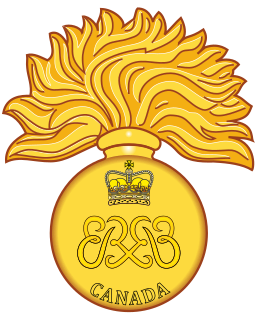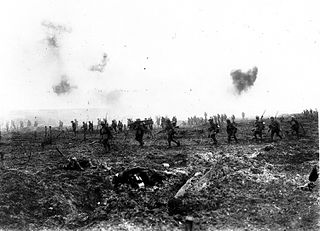
The Canadian Grenadier Guards (CGG) is a reserve infantry regiment in the 34 Canadian Brigade Group, 2nd Canadian Division, of the Canadian Army. The regiment is the oldest and second-most-senior infantry regiment in the Primary Reserve of the Canadian Army. Located in Montreal, its primary role is the provision of combat-ready light infantry troops in support of Canadian regular infantry. It is a Household Foot Guard regiment and also provides soldiers for public ceremonial duties, performing similar ceremonial duties to the Guards regiments of the British Army. This primarily entails mounting the guard on Government House, the Governor General's residence, and performing the "Changing the Guard" ceremony on Parliament Hill in Ottawa, a task it shares with Canada's senior Household Foot Guard regiment, the Governor General's Foot Guards of Ottawa. The Canadian Grenadier Guards is an allied regiment to the British Grenadier Guards.

The British Columbia Regiment is a Primary Reserve armoured reconnaissance (recce) regiment of the Canadian Army; the regiment is subordinate to 39 Canadian Brigade Group of the 3rd Canadian Division. Established in 1883, it is the oldest military unit in Vancouver, British Columbia, Canada. It parades at the Beatty Street Drill Hall at the corner of Dunsmuir and Beatty in Downtown Vancouver. The regiment has been variously designated as garrison artillery, rifles, infantry, and armoured, but has been reconnaissance since 1965. It has received 41 battle honours in its history, and has been a unit of the Royal Canadian Armoured Corps since 1942.
The 176th Battalion, CEF, was a unit in the Canadian Expeditionary Force during the First World War.

The 207th (Carleton) Battalion, CEF was a battalion of the First World War Canadian Expeditionary Force.
The 121st Battalion, CEF was a unit in the Canadian Expeditionary Force during the First World War. Based in New Westminster, British Columbia, the unit was authorized on 22 December 1915 and began recruiting in that city. After sailing to England on RMS Empress of Britain in August 1916, the battalion was absorbed into the 16th Reserve Battalion on January 10, 1917. The 121st Battalion, CEF had one Officer Commanding: Lieutenant-Colonel Archibald Woodbury McLelan.

The 133rd Battalion, CEF was a unit in the Canadian Expeditionary Force during the First World War.
The 142nd Battalion, CEF was a unit in the Canadian Expeditionary Force during the First World War. Based in London, Ontario, the unit began recruiting in late 1915 in that city. After sailing to England in November 1916, the battalion was absorbed into the 23rd Reserve Battalion, CEF on November 11, 1916. The 142nd Battalion had one Officer Commanding: Lieutenant-Colonel C.M.R. Graham.
The 158th Battalion, CEF was a unit in the Canadian Expeditionary Force during the First World War. Based in Vancouver, British Columbia, the unit began recruiting in late 1915 in that city. After sailing to England in November 1916, the battalion was absorbed into the 1st Reserve Battalion on January 6, 1917. The 158th Battalion, CEF had one Officer Commanding: Lieut-Col. C. Milne.

The 31st Battalion (Alberta), CEF, was an infantry battalion of the Canadian Expeditionary Force during the Great War. The battalion recruited in Alberta and was mobilized at Calgary. The battalion was authorized in November 1914 and embarked for Britain on 17 May 1915. On 18 September 1915 it disembarked in France, where it fought with the 6th Infantry Brigade, 2nd Canadian Division in France and Flanders until the end of the war. The battalion was disbanded in August 1920.
The 253rd Battalion, CEF, was a unit in the Canadian Expeditionary Force during the First World War. Based in Kingston, Ontario, the unit began recruiting in mid-autumn of 1916, primarily among university students from throughout Canada. After sailing to England in May 1917, the unit was absorbed by the 5th Reserve Battalion, CEF, later that month. The 253rd Battalion, CEF, had one officer commanding: Lieutenant-Colonel P. G. C. Campbell.
Ranger most often refers to:

The 29th Battalion (Vancouver), CEF was an infantry battalion of the Canadian Expeditionary Force during the Great War.
Irish Rangers may refer to:
The 23rd Reserve Battalion, CEF was an infantry unit in the Canadian Expeditionary Force during the First World War.

The 2nd Canadian Mounted Rifles Battalion, was authorized on 7 November 1914 as the 2nd Regiment, Canadian Mounted Rifles, CEF. The battalion recruited in Victoria and Vernon, British Columbia and was mobilized in Victoria. An earlier incarnation was raised for Boer War.

The 5th Battalion, CEF, known as "Tuxford's Dandys," was an infantry battalion of the Canadian Expeditionary Force during the Great War.

The 46th Battalion, CEF, was an infantry battalion of the Canadian Expeditionary Force during the Great War.

The 73rd Battalion, CEF was an infantry battalion of the Canadian Expeditionary Force during the Great War. The 73rd Battalion organized in June 1915, initially commanded by Lieutenant-Colonel Peers Davidson, was placed on 'Active Service' as an 'Overseas Battalion, on 10 July 1915, as authorized in Militia General Orders.

The 95th Battalion, CEF, was an infantry battalion of the Great War Canadian Expeditionary Force. It was formed in December 1915, and trained at Shorncliffe Army Camp in Kent. It did not see combat as an independent unit; its soldiers were used to reinforce other Canadian units in the field in Belgium and France. The 95th was disbanded in July 1917.
The Irish Canadian Rangers were an infantry regiment of the Non-Permanent Active Militia of the Canadian Militia. In 1936, the regiment was disbanded as a result of a country wide reorganization of the Canadian Militia.












